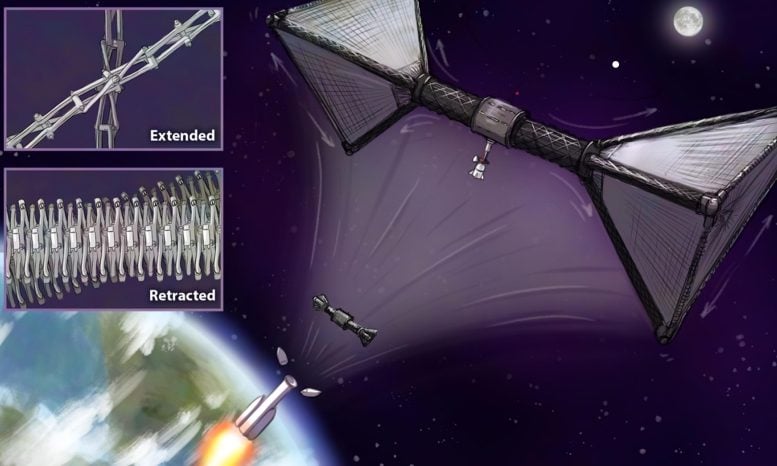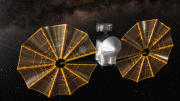Sustained human presence in space has been a core goal of NASA for decades. NASA’s recent Plan for Sustained Lunar Exploration and Development lays out a vision for long-term human exploration of cislunar space, on the lunar surface, and on Mars as part of the Artemis program. Long-duration spaceflight poses serious challenges for the human body, including muscle atrophy, bone loss, eyesight degradation, and immunosuppression. Many of these effects are linked to a lack of gravity.
While significant progress has been made in mitigating individual symptoms associated with long-term zero-g exposure, the ability to generate artificial gravity would eliminate the root cause of many problems, and could greatly improve crew health on long-duration missions.
Concepts for rotating space habitats as a means for generating artificial gravity date back more than a century. However, humans suffer discomfort from exposure to rotation rates as low as 3 RPM. To produce artificial gravity near 1g at rotation rates of 1-2 RPM, a kilometer-scale structure is needed.
The core of our solution is a high-expansion-ratio deployable structure (HERDS) built from mechanical metamaterials. Specifically, we exploit two kinematic discoveries made in the last 5 years: shearing auxetics and branched scissor mechanisms. We intend to produce tube structures with an unprecedented 150x expansion ratio.
Our Phase I NIAC study has demonstrated the viability of this approach and pointed us to several technical problems that must be addressed in Phase II.
The key technical work in Phase II will be focused on four specific thrusts:
- Modeling and understanding the complex deployment dynamics of our expanding hierarchical structure in detail.
- Mitigating jamming during deployment in the presence of manufacturing errors and external disturbances using simulation and design optimization.
- Rapid prototyping and hardware-based design iteration to calibrate models and evaluate sub-system components.
- Experimental validation of meter-scale prototypes with thousands of links to demonstrate deployment without jamming and high expansion ratios.
This work will have immediate and long term impact for NASA’s objectives. In the near term, such a structure would make sustained human habitation in cislunar space, for example, as part of the Lunar gateway, possible. In the medium-to-longer term, such structures will be critical to sustaining humans in deep space. Finally, large structures will also advance astronomy by supporting large-scale telescope arrays.
By Zac Manchester, Carnegie Mellon University.










Expanding a structures size isnt going to increase its mass and this plan seems so bizarre
Would such a large structure be vulnerable to space debris / meteorites?
@Jamal
I too impulsively thought it ridiculous to imply that large objects without large mass could create artificial gravity. I then read the rest of the article and realized that they really meant to say to simulate gravity. The idea is that the large structure spins so that the habitable area inside would have a simulated gravity force by flinging the occupants outward at all times.
This —
“To produce artificial gravity near 1g at rotation rates of 1-2 RPM, a kilometer-scale structure is needed”
— isn’t very challenging, if experience on the ground is any guide. The Zugspitse-Eibsee ropeway supports a ~100-person cabin on a cable that reaches down *3.2* km to it. All the weight of the cable and the cabin are supported at the top.
The “top”, in the corresponding space structure, would be at the middle. From there, one 3.2-km set of cables could reach down to a cabin, and another equally long set could reach down in exactly the opposite direction, to another cabin. Weighing outward from the middle due to spin, their weights would cancel each other at the middle, where the two sets of cables would join. Or — more sensibly — they would have been one, 6.4-km cable set all along.
The cabins would be at one gee. The middle would be at zero gees. The average ‘g’ along each set of cables reaching down would be half a gee. Not a whole gee, as in the Zugspitse-Eibsee ropeway, so the load at the top, which, just to repeat, is at the middle, would be less than at the top of that ropeway. Spin-gravity structures’ tops are at their middles.
This all works well for a load-bearing set of continuous tension cables. If a spacecraft delivered them to orbit coiled on an even number of spools, and the whole setup was given a little spin so that half the spools hung at low ‘g’ from the other half, they could all then be unspooled slowly, with tangential thrust at the ends keeping the spin rate constant despite the slow increase of the moment of inertia. A little gravity is all the initial spin gives, but that’s all you need, and as the ends get farther out, their ‘g’ increases until they are at one gee and we stop.
In Zac Manchester’s “shearing auxetics and branched scissor mechanisms” approach, letting that many-jointed structure use a little spin gravity to stretch itself out isn’t mentioned. It’s not certain the plan isn’t to *push* it out, taking no advantage of gravity.
Eventually it will be all the way out, and then, with payloads at the ends, it will be spun up? Is that right? If so, it will then bear, through all those joints, the Earth-normal weight of those payloads, same as the set of continuous cables.
It’s an interesting approach.
Mass is not important it’s the rotational speed they need to reach without causing the astronauts to puke
Mass is important if they plan on doing it in one launch.